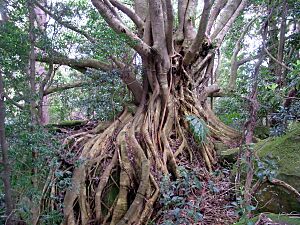Foxground, New South Wales facts for kids
Quick facts for kids FoxgroundNew South Wales |
|||||||||||||||
|---|---|---|---|---|---|---|---|---|---|---|---|---|---|---|---|

Foxground Valley
|
|||||||||||||||
| Population | 164 (2021 census) | ||||||||||||||
| Postcode(s) | 2534 | ||||||||||||||
| Elevation | 77 m (253 ft) | ||||||||||||||
| Location | |||||||||||||||
| LGA(s) | Municipality of Kiama | ||||||||||||||
| State electorate(s) | Kiama | ||||||||||||||
| Federal Division(s) | Gilmore | ||||||||||||||
|
|||||||||||||||
Foxground is a small place, also called a locality, in the Illawarra region of New South Wales, Australia. It's part of the Municipality of Kiama. This area is known for its beautiful valley, where Broughton Creek flows. Foxground is about 20 kilometres (12 miles) southwest of Kiama.
Contents
The Name Foxground
The name Foxground comes from the many grey-headed flying foxes that used to live here. These are a type of large bat. People once called this area "The Flying Foxes Camping Ground." In 1890, there were even attempts to remove the flying foxes using explosions.
Early History of Foxground
First People and Settlers
The original people of this area were the Wadi Wadi and Yuin tribes. They are Indigenous Australians, meaning they were here long before European settlers arrived.
The first European visitors to the valley were likely cedar cutters in the 1820s. These were people who cut down valuable red cedar trees. Some cedar cutters were exploring nearby Gerringong as early as 1814.
After the rainforest was cleared, the land was mostly used for dairy farms. John Blow was one of the first European settlers. He first built a simple house from wood and bark. Later, he built a new home called "Willow Glen," which is still standing today.
Foxground Today
Foxground is now a quiet rural valley. It no longer has the shops, school, or churches it once did. The local school closed in 1950. A Church of England building, built in 1873, was destroyed by fire in 1954. A Wesleyan church, built in 1861, was sold in 1901.
Wildlife Sanctuary
In 1962, a photographer named Jeff Carter and his wife Mare moved to an abandoned farm in Foxground. They turned their 45-hectare (111-acre) property into a wildlife sanctuary. Mare wrote a book about their experiences called A Wild Life — Bringing up a Bush Menagerie. It tells the story of how they cared for many different animals.
Nature and Environment
Foxground has very fertile soil and gets a lot of rain. This helps a beautiful sub-tropical rainforest grow.
Important Plants
Many important trees grow here. These include:
- Australian red cedar (Toona ciliata)
- Camphorwood (Cinnamomum oliveri)
- Yellow ash (Emmenosperma alphitonioides)
- Deciduous fig (Ficus superba var. henneana)
- Illawarra plum (Podocarpus elatus)
A rare plant called socketwood (Daphnandra johnsonii) also grows on private property in the area.

Rainfall
Foxground gets a lot of rain. The average yearly rainfall in nearby Kiama is 1,256 millimetres (49.4 inches). However, in 1950, Foxground received an amazing 4,263 millimetres (167.8 inches) of rain. This was one of the highest annual rainfalls ever recorded in New South Wales!


